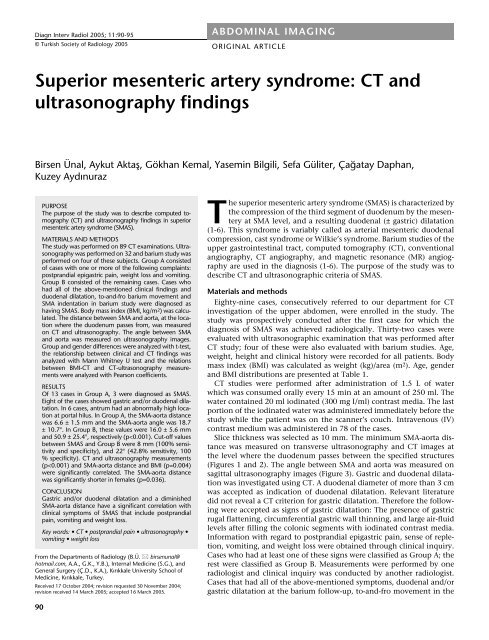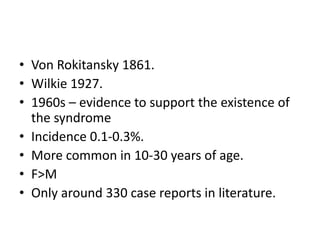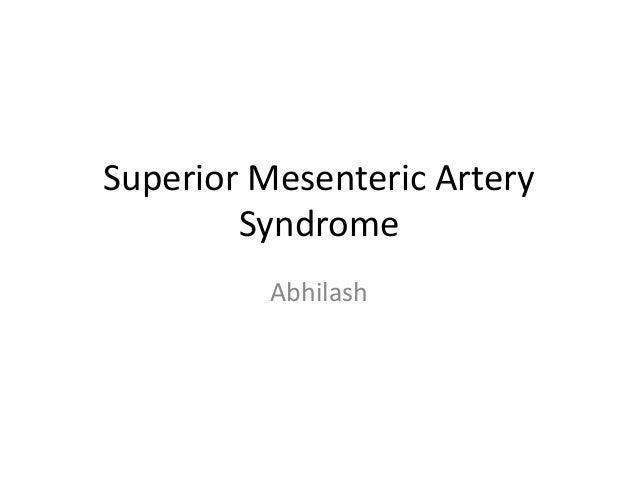Your Superior mesenteric artery syndrome age images are ready. Superior mesenteric artery syndrome age are a topic that is being searched for and liked by netizens now. You can Get the Superior mesenteric artery syndrome age files here. Download all free photos.
If you’re looking for superior mesenteric artery syndrome age images information related to the superior mesenteric artery syndrome age keyword, you have visit the ideal blog. Our website frequently provides you with suggestions for downloading the highest quality video and image content, please kindly hunt and find more enlightening video articles and images that match your interests.
Superior Mesenteric Artery Syndrome Age. Axial C portal venous phase Angle between SMA and aorta decreased 13 degrees and duodenum is dilated before this section. Superior mesenteric artery syndrome SMAS is a rare but complicated medical problem. Superior mesenteric artery syndrome was found more often in children with an intellectual disability. Females are impacted more often than males and while the syndrome can occur at any age it is most frequently diagnosed in early adulthood.
 A Diagnostic Criteria Of Superior Mesenteric Artery Syndrome Are Based Download Scientific Diagram From researchgate.net
A Diagnostic Criteria Of Superior Mesenteric Artery Syndrome Are Based Download Scientific Diagram From researchgate.net
Patients undergoing spinal fusion surgery for scoliosis with a BMI of less than 18 are at risk to develop SMA syndrome postoperatively. Superior mesenteric artery syndrome SMAS is a rare but complicated medical problem. The aim of the study was to evaluate clinical and nutritional outcome in children with idiopathic SMAS. The Superior Mesenteric Artery Syndrome SMAS likely involves a young patient especially female and is especially associated with rapid weight loss resulting in. Male From the case. Up to 10 cash back Purpose To provide a review of the etiology clinical presentation and imaging findings of superior mesenteric artery SMA syndrome.
ConfigCtrl2infometaDescription This site uses cookies.
A 1-year prospective observation study of effects of treatment and outcome was performed in 27. The superior mesenteric artery syndrome usually occurs in older children and adolescents. Superior mesenteric artery SMA syndrome has been reported as an uncommon condition of external vascular compression of the SMA particularly after rapid weight loss body casts or after corrective surgery for spinal deformities usually within the first few weeks after surgery. Superior mesenteric artery syndrome SMAS is a rare condition in which the superior mesenteric artery SMA impinges on the third portion of the duodenum leading to symptoms of gastric outlet obstruction1 When conservative management fails surgical intervention may be required. Male From the case. The initial presentations of HMSN type II were developmental delay and gait disturbance at 2.
 Source: researchgate.net
Source: researchgate.net
Up to 10 cash back Purpose To provide a review of the etiology clinical presentation and imaging findings of superior mesenteric artery SMA syndrome. A 1-year prospective observation study of effects of treatment and outcome was performed in 27. By continuing to browse this site you are agreeing to our use of cookies. Results Clinicians and radiologists with a high index of suspicion based on symptomatology may. This is a retrospective report of a case of a non-verbal autistic female.

SMAS also known as Cast syndrome chronic duodenal ileus or Wilkies syndrome 1 2 3 is an intestinal obstruction due to vascular compression of the third part of duodenum by the superior mesenteric artery against the abdominal aorta due to an aortomesenteric angle of. Contrast-enhanced CT confirmed narrow angle between aorta and SMA 20 with decreased intervening distance in axial plane 55 mm. This compression causes partial or complete blockage of the duodenum. Research shows that the most people affected by superior mesenteric artery syndrome are teens and young adults. Epidemiologically females are more commonly affected with two-thirds of patients 10 to 40 years of age 1.
 Source: researchgate.net
Source: researchgate.net
Herein we report what we believe is the first case of coexisting nutcracker and SMA syndrome in a patient with. In one report 75 of the cases occurred in patients aged 10-30 years. Male From the case. Females are impacted more often than males and while the syndrome can occur at any age it is most frequently diagnosed in early adulthood. Superior mesenteric artery syndrome SMAS is a rare but complicated medical problem.
 Source: researchgate.net
Source: researchgate.net
This review is directed at increasing awareness of two diverse rare upper gastrointestinal problems that occur at opposite ends of the age spectrum and are difficult to diagnose and treat. Symptoms vary based on severity but can be severely debilitating. Superior mesenteric artery syndrome SMAS is a digestive condition that occurs when the duodenum the first part of the small intestine is compressed between two arteries the aorta and the superior mesenteric artery. This review is directed at increasing awareness of two diverse rare upper gastrointestinal problems that occur at opposite ends of the age spectrum and are difficult to diagnose and treat. Compressed 3rd part of duodenum at the site of crossing between aorta and SMA with subsequent mild proximal duodenal and gastric dilatation.
 Source: yumpu.com
Source: yumpu.com
As the syndrome involves a lack of essential fat more than half of those diagnosed are underweight sometimes to the point of sickliness and emaciation. Epidemiologically females are more commonly affected with two-thirds of patients 10 to 40 years of age 1. Nutcracker and superior mesenteric artery SMA syndrome share the same pathogenesis but the simultaneous occurrence of both diseases is quite rare. Superior mesenteric artery syndrome can occur at any age. A 14-year-old girl with superior mesenteric artery SMA syndrome associated with hereditary motor and sensory neuropathy HMSN type II is reported.
 Source: diseasemaps.org
Source: diseasemaps.org
There are no available data for outcomes in childrens idiopathic superior mesenteric artery syndrome SMAS strictly treated conservatively. Superior mesenteric artery syndrome SMAS is a rare condition in which the superior mesenteric artery SMA impinges on the third portion of the duodenum leading to symptoms of gastric outlet obstruction1 When conservative management fails surgical intervention may be required. These data highlight the need to consider SMAS if there is difficulty tolerating gastrostomy tube feedings in patients with weight-for-age percentiles less than 5. In patients who are not surgical candidates or who decline surgery EUS-guided. A risk factor for superior mesenteric artery syndrome in adolescents undergoing spinal fusion for scoliosis.
 Source: researchgate.net
Source: researchgate.net
SMAS also known as Cast syndrome chronic duodenal ileus or Wilkies syndrome 1 2 3 is an intestinal obstruction due to vascular compression of the third part of duodenum by the superior mesenteric artery against the abdominal aorta due to an aortomesenteric angle of. Research shows that the most people affected by superior mesenteric artery syndrome are teens and young adults. CT criteria for the diagnosis of SMA syndrome include an aortomesenteric angle of less than 22 degrees or an aortomesenteric distance of less than 8 to 10 mm 5. Axial C portal venous phase Angle between SMA and aorta decreased 13 degrees and duodenum is dilated before this section. Epidemiologically females are more commonly affected with two-thirds of patients 10 to 40 years of age 1.
 Source: diseasemaps.org
Source: diseasemaps.org
Age2713 This age and sex distribution may simply reflect the predisposing cause of the condition and in particular eating disorders. Superior mesenteric artery syndrome SMAS is a rare condition in which the superior mesenteric artery SMA impinges on the third portion of the duodenum leading to symptoms of gastric outlet obstruction1 When conservative management fails surgical intervention may be required. Compressed 3rd part of duodenum at the site of crossing between aorta and SMA with subsequent mild proximal duodenal and gastric dilatation. Superior mesenteric artery syndrome was found more often in children with an intellectual disability. Age2713 This age and sex distribution may simply reflect the predisposing cause of the condition and in particular eating disorders.
 Source: radiopaedia.org
Source: radiopaedia.org
SMAS also known as Cast syndrome chronic duodenal ileus or Wilkies syndrome 1 2 3 is an intestinal obstruction due to vascular compression of the third part of duodenum by the superior mesenteric artery against the abdominal aorta due to an aortomesenteric angle of. Research shows that the most people affected by superior mesenteric artery syndrome are teens and young adults. Superior mesenteric artery syndrome SMAS is a digestive condition that occurs when the duodenum the first part of the small intestine is compressed between two arteries the aorta and the superior mesenteric artery. The initial presentations of HMSN type II were developmental delay and gait disturbance at 2. Superior mesenteric artery syndrome SMAS is a rare condition in which the superior mesenteric artery SMA impinges on the third portion of the duodenum leading to symptoms of gastric outlet obstruction1 When conservative management fails surgical intervention may be required.
 Source: slideshare.net
Source: slideshare.net
Symptoms vary based on severity but can be severely debilitating. Ring artifact is also present. Symptoms vary based on severity but can be severely debilitating. Superior mesenteric artery syndrome. Age2713 This age and sex distribution may simply reflect the predisposing cause of the condition and in particular eating disorders.
 Source: pt.slideshare.net
Source: pt.slideshare.net
This review is directed at increasing awareness of two diverse rare upper gastrointestinal problems that occur at opposite ends of the age spectrum and are difficult to diagnose and treat. Superior mesenteric artery syndrome can occur at any age. A combination of the nutcracker syndrome and IgA nephropathy has previously been reported. Superior mesenteric artery syndrome SMAS is a rare condition in which the superior mesenteric artery SMA impinges on the third portion of the duodenum leading to symptoms of gastric outlet obstruction1 When conservative management fails surgical intervention may be required. As the syndrome involves a lack of essential fat more than half of those diagnosed are underweight sometimes to the point of sickliness and emaciation.
 Source: studylib.net
Source: studylib.net
There are no available data for outcomes in childrens idiopathic superior mesenteric artery syndrome SMAS strictly treated conservatively. ConfigCtrl2infometaDescription This site uses cookies. Females are impacted more often than males and while the syndrome can occur at any age it is most frequently diagnosed in early adulthood. Ring artifact is also present. Axial C portal venous phase Angle between SMA and aorta decreased 13 degrees and duodenum is dilated before this section.
 Source: step2.medbullets.com
Source: step2.medbullets.com
In patients who are not surgical candidates or who decline surgery EUS-guided. It is necessary to think of it in front of any high obstruction in a patient with severe weight. Patients undergoing spinal fusion surgery for scoliosis with a BMI of less than 18 are at risk to develop SMA syndrome postoperatively. A 1-year prospective observation study of effects of treatment and outcome was performed in 27. Superior mesenteric artery syndrome SMAS is a rare condition in which the superior mesenteric artery SMA impinges on the third portion of the duodenum leading to symptoms of gastric outlet obstruction1 When conservative management fails surgical intervention may be required.
 Source: researchgate.net
Source: researchgate.net
Low body mass index. SMAS also known as Cast syndrome chronic duodenal ileus or Wilkies syndrome 1 2 3 is an intestinal obstruction due to vascular compression of the third part of duodenum by the superior mesenteric artery against the abdominal aorta due to an aortomesenteric angle of. Superior mesenteric artery syndrome can occur at any age. Epidemiologically females are more commonly affected with two-thirds of patients 10 to 40 years of age 1. This compression causes partial or complete blockage of the duodenum.
 Source: researchgate.net
Source: researchgate.net
It is necessary to think of it in front of any high obstruction in a patient with severe weight. Herein we report what we believe is the first case of coexisting nutcracker and SMA syndrome in a patient with. The aim of the study was to evaluate clinical and nutritional outcome in children with idiopathic SMAS. SMAS also known as Cast syndrome chronic duodenal ileus or Wilkies syndrome 1 2 3 is an intestinal obstruction due to vascular compression of the third part of duodenum by the superior mesenteric artery against the abdominal aorta due to an aortomesenteric angle of. A 1-year prospective observation study of effects of treatment and outcome was performed in 27.
 Source: slidetodoc.com
Source: slidetodoc.com
Females are impacted more often than males and while the syndrome can occur at any age it is most frequently diagnosed in early adulthood. Symptoms vary based on severity but can be severely debilitating. Superior mesenteric artery syndrome SMAS is a rare condition in which the superior mesenteric artery SMA impinges on the third portion of the duodenum leading to symptoms of gastric outlet obstruction1 When conservative management fails surgical intervention may be required. These data highlight the need to consider SMAS if there is difficulty tolerating gastrostomy tube feedings in patients with weight-for-age percentiles less than 5. The aim of the study was to evaluate clinical and nutritional outcome in children with idiopathic SMAS.
 Source: researchgate.net
Source: researchgate.net
Females are impacted more often than males and while the syndrome can occur at any age it is most frequently diagnosed in early adulthood. Results Clinicians and radiologists with a high index of suspicion based on symptomatology may. Contrast-enhanced CT confirmed narrow angle between aorta and SMA 20 with decreased intervening distance in axial plane 55 mm. Superior mesenteric artery syndrome was found more often in children with an intellectual disability. These data highlight the need to consider SMAS if there is difficulty tolerating gastrostomy tube feedings in patients with weight-for-age percentiles less than 5.
 Source: youtube.com
Source: youtube.com
A risk factor for superior mesenteric artery syndrome in adolescents undergoing spinal fusion for scoliosis. The initial presentations of HMSN type II were developmental delay and gait disturbance at 2. Superior mesenteric artery syndrome is a rare cause of proximal small bowel obstruction and is linked to notable morbidity and mortality when the diagnosis is delayed. In one report 75 of the cases occurred in patients aged 10-30 years. As the syndrome involves a lack of essential fat more than half of those diagnosed are underweight sometimes to the point of sickliness and emaciation.
This site is an open community for users to do submittion their favorite wallpapers on the internet, all images or pictures in this website are for personal wallpaper use only, it is stricly prohibited to use this wallpaper for commercial purposes, if you are the author and find this image is shared without your permission, please kindly raise a DMCA report to Us.
If you find this site adventageous, please support us by sharing this posts to your preference social media accounts like Facebook, Instagram and so on or you can also bookmark this blog page with the title superior mesenteric artery syndrome age by using Ctrl + D for devices a laptop with a Windows operating system or Command + D for laptops with an Apple operating system. If you use a smartphone, you can also use the drawer menu of the browser you are using. Whether it’s a Windows, Mac, iOS or Android operating system, you will still be able to bookmark this website.






